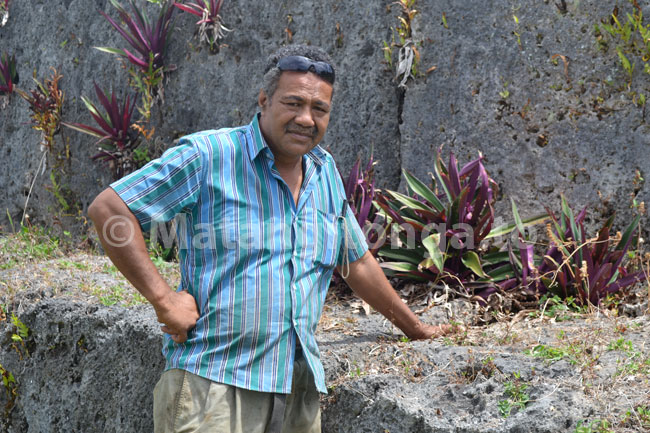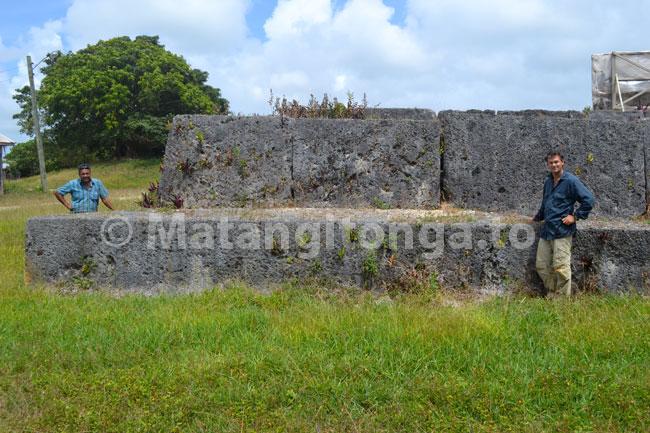
By Mary Lyn Fonua
Tonga's ancient stonework monuments are unique in the Pacific, and the largest of them, Lapaha's Paepae 'o Tele'a tombs, are to be submitted for recognition as a World Heritage Site.
Dr Geoffrey Clark of the Australian National University, Canberra, Department Archaeology and Natural History, visited Tonga in December 2012 to help the Lapaha community and Tonga Government prepare a dossier for formal submission to UNESCO in a bid to win recognition of the Paepae 'o Tele'a tombs as a World Heritage Site.
The stone tombs, built on reclaimed land in an old harbour, date back to the Maritime Empire of the Tu'i Tonga chiefdom that started building its capital at Lapaha in eastern Tongatapu, around 1,000 years ago.
"These are some of the best-preserved sites and obviously the Paepae is the most extensive piece of stonework or the biggest stonework monument in terms of the weight of stone that we have in the Pacific," said Dr Clark.
Today, much of the base of structure is underground, and the tombs look weathered and grey, and different from when they were first built as shining monuments.
White limestone
"When first cut, the limestone was all fresh white surface, and they used all the white limestone rubble to make a kind of a courtyard - so if you were coming from the lagoon when this was built it was a very reflective structure. If you imagine it is almost like a new building and the sun is hitting it and bouncing off. It is quite blinding, especially with that courtyard in front of it, so obviously it's about that kind of sacredness that comes to the Tu'i Tonga, that is all part of it. Over time, the landscape might look different but they are still very impressive structures, and we can imagine how they were when they were fresh gravel and fresh limestone surfaces.
"There is a wharf there and there used to be a small harbour," he said.
Dr Clark conducted a geophysical investigation of the sites several years ago with the help of Nivaleti Melekiola (Tu'akilaumea), the Lapaha town officer, who also has a special traditional role as a Falefa, or royal undertaker. Niva has been collecting historical information from people.
"We call this one Langi, but the name of the Langi is Paepae 'o Telea (the platform of Telea). The smaller Langi is Namoala," said Niva.
Some of the tombs have got stacked vaults one on top of the other, and they have been used also for burials in modern times. Because there are bones around the outside of the ancient vaults Niva does not count out the possibility that sitting or standing attendants were buried with the chiefs.
"It can be possible because when we found the body of the chief, it is around where the vault is, probably, of course you see the bones and don't know if sitting. Other skeletons around it look like somehow sitting, standing," Niva said.
His information comes not from archaeology but from when the Ha'a Tufunga are preparing the modern burial sites in the tombs.

Nivaleti Melekiola (Tu'akilaumea) at the Paepae 'o Tele'a
Tonga Maritime Empire
Dr Clark has worked in Fiji, Samoa, Tonga and through Western Micronesia looking at very early human settlement of the Lapita people, and did post-doctoral research to look at the Tonga Maritime Empire, in the later stage of human expansion.
"Obviously at Paepae they are really carefully fitting the blocks and putting them together and there is about 500 tons of stone in Paepae alone - which makes it really one of the biggest.
"In terms of making quarry blocks Paepae certainly stands out in that regard and also the engineering, they have got corner blocks that go round the corner."
Reclaimed land
Dr Clark said the structure is surrounded by reclaimed land. "When excavated the total height of the [base] stone is about two metres. So most of them are underground. They've been put into an inter-tidal quite a wet part of the lagoon and this is all reclaimed land we are sitting on. The reclaimed land goes all the way out to the edge of the lagoon. It's a very large area," he said.
"The lands that we can see when we are excavating are the debris left from shaping the stones, so it's limestone fill. There was water with a bit of mud, then they got coral from the lagoon and they made a base, and they started putting the rubble from shaping the blocks and finally they put a mound of dirt you can see from Paepae up to Namoala, and the point of that dirt was simply to hold the blocks."
The massive, specially carved "Makaofe" corner stones at Paepae have held the structure together for hundreds of years.
"Normally, stones are just edge-to-edge, of course, so when you have got weight on the inside it creates an engineering problem because the corner splits open and the filling spills out."
"It is unique in the Pacific this kind of structure, for sure. Even in Tahiti and other places they are using slabs, but often natural slabs and boulders to make up the structure."
Settlement
Dr Clark said the fascination with the beginning as well as the later stage of settlement that they are looking at in the area, represents two major phases of human expansion in the Pacific Islands.
"So in the first one is the Lapita people who are moving out probably coming down from island Southeast Asia going to Bismark Archipelago, and then moving through the Pacific where they are finding all these uninhabited island groups, Vanuatu New Caledeonia, Fiji, Tonga Samoa. And then it stops and then there isn’t much expansion in the Pacific for 2000 years.
"Around a thousand years ago we start to see chiefdoms developing of which the Tu'i Tonga chiefdom is obviously a major one and at the same time we see a new expansion of people they are going both east and west and there is an Eastward expansion into east Polynesia .And there is also a backward migration. So the big thing and most interesting thing for us is why do you have these phases of expansion?" he said.
"With the Tu'i Tonga chiefdom what we have been able to show is that the maritime ability or connections of the chiefdom were significant. For example, when they were making the blocks here at Paepae small fragments of the stone tools fell down and when we collect those and do the geochemistry of them we can trace the origins so we found a lot of the stone tools came from Samoa, there's a lot from Fiji and there's a lot from other parts of Tonga. So you can really see the maritime capacity or ability of the people was quite major because it is 900km up to Samoa from here, another 700km over to Viti Levu where they are getting some of the stone for the stone tools to shape the blocks.
"I think it is just showing the scale of the connections that were going on. The Tu'i Tonga was able to call on or command tools or people from these places to come and work on their tombs and that does not happen earlier."
Sense of identity
Dr Clark said that the local community and the noble Kalaniuvalu Fotofili along with Princess Si'ilikutapu and the Lapaha Town council under Niva wanted to see the heritage of Lapaha recognized for future generations..
"Because it's always been a centre here and there's still the remnants of that centre and it still provides a real focus for the community to know that they come from the place that was once the kind of capital of Tonga."
He said that Lord Vaea formally of the Tonga Traditions Committee and now Minister of Internal Affairs had been the Tongan representative to World Heritage meetings for a long time.
"What the World Heritage noticed was that when they looked at the representation of different geographic regions, the Pacific was way under-represented. So you've got cathedrals in Europe and you've got pyramids, and the Great Wall of China. The Pacific had almost no sites, if you took out Australia, New Zealand and Hawaii from the picture. UNESCO was very keen to remedy this and asked Pacific countries to make it formal, so at the same time the community was saying things were important in terms of sites, so was the government of Tonga, and also through the research project I had, we've been trying to work and provide the expert information necessary, that comes out of our research, which is essential, to prove or validate that some things are of world heritage value," he said.
To receive World Heritage status you have to show your sites have Outstanding Universal Value and to show that something that had significance in the past continues unbroken in terms of use or practice with the current day.
The process of preparing a dossier and going through stages of expert evaluation is expected to take at least three years.





